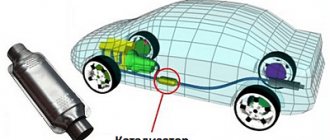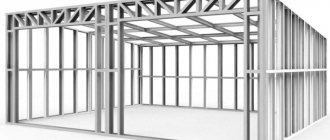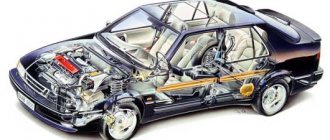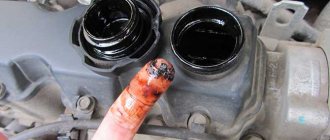What is a car muffler for?
Regardless of the make and year of manufacture of the car, all its systems serve one purpose - to ensure stable operation of the engine and movement. The exhaust system may seem insignificant compared to systems such as the brakes or fuel. However, it is the vehicle's exhaust system that has the most direct impact on engine performance.
The muffler is an integral part of the exhaust system . Its main purpose is to remove exhaust gases outside the car. In addition, the part also serves to reduce noise, since residual fuel can burn in the exhaust system pipes.
The pipe comes out from the rear left side of the car
How to attach
The muffler on the VAZ 2114/2115 is attached to the car body. To ensure that the pipe is securely fixed and does not vibrate during movement, two fastening methods are used:
on rubber suspensions.
Bolts and nuts for fastening the muffler pipes are made of special heat-resistant alloys
The muffler is attached directly to the exhaust manifold with bolted connections, which guarantee complete tightness of the joints. The middle part is also fixed with bolts and nuts. And the resonator and exhaust pipe are suspended on special hooks on the bottom with elastic bands. These suspensions are easy to remove and put on, but at the same time provide rigidity even when driving on uneven roads.
Schematic design of the exhaust system on a VAZ 2114/2115
The gas exhaust system of the VAZ 2114/2115 consists of several parts. Connecting to each other in series, all parts ultimately serve one purpose - reducing noise and removing exhaust emissions outside the body.
1 — bracket for fastening the exhaust pipe; 2 - gasket; 3 — clamping device for the bracket; 4 — additional muffler; 5.7 — “pillows” for muffler suspension; 6 — main muffler; 8 — clamp connecting the muffler pipes; 9 - neutralizing device; 10 — hinge sealing ring; 11 - sensor that monitors the oxygen concentration in emissions; 12 — exhaust pipe for mufflers
Assembling a new direct-flow muffler
This method is preferable for lovers of an exciting sports exhaust sound. It is advisable to cut off the bent part of the inlet pipe from the old muffler and weld it to the new one. Bending a new one in this way is a labor-intensive and time-consuming process.
- Weld flanges to the perforated pipe on both sides.
- Wrap the pipe with steel mesh or heat-resistant fabric.
- Select a steel pipe with a diameter approximately equal to the flanges, put it on the structure, while simultaneously filling the internal space with mineral wool or a material with similar properties.
- Weld the joints of the pipe with the flanges.
Creating a new direct flow with your own hands has a significant disadvantage. It is impossible for a non-professional to make an aesthetic structure from chrome-plated pipes: it requires skills and special welding equipment (at least a semi-automatic machine, preferably an argon welding machine). In addition, fastenings must be provided for the new muffler - and this is additional work.
Another problem is the choice of pipe for the new housing. Thin-walled ferrous metal can quickly burn out, and a thick-walled pipe (4-5 mm) greatly burdens the structure. Standard rubber hangers won't last long. The optimal choice is the golden mean.
If you decide to make a direct-flow muffler with your own hands, it is better to settle on assembling it in an old housing. It's faster, more practical and requires less skill and equipment.
What to expect from a straight-through muffler:
- slight increase in engine power (with significant modification of the exhaust system)
- improved exhaust sound at rpm.
And what not to do:
- acceleration 0-100 in 8-9 seconds.
Tuning the exhaust system of a VAZ 2114 only frees 5-6 horses “stayed in the stalls”. It affects acceleration and, especially, the maximum speed of the car insignificantly.
How to replace a muffler on a VAZ 2114/2115
If you start having any problems with the muffler, it is better not to put it off for a long time. The life and health of the driver and passengers depends on how correctly the “glushak” works. In general, the replacement process itself begins with the selection of a new exhaust system kit. It is best not to save money, but to purchase an original factory one. This will delay the need for repeated replacement indefinitely.
In addition, it is recommended to change the fastening bolts during each replacement. It is necessary to choose products made from heat-resistant materials, since otherwise the bolts will quickly stick to the bottom and will be impossible to unscrew.
To ensure reliable operation, it is advisable to buy new rubber suspensions in advance.
What tools will you need?
To work you will need a simple set of tools:
two open-end wrenches for 13;
brake fluid or WD-40 lubricant;
screwdriver with a flat thin blade.
How to remove a muffler without a hole
The easiest way is to use an overpass or inspection hole - in this case, you can more conveniently crawl under the car body and carry out the necessary operations. However, drivers often do not have the opportunity to use such devices, so they use a regular jack.
To remove the “glushak” from a VAZ 2114/2115, you must:
Jack up the rear left edge of the vehicle.
Make sure the machine is stable.
Reach under the body and moisten all pipe connections and bolts with lubricant.
Wait 10–15 minutes until the liquid is absorbed.
After which you can begin to unscrew the bolted connections. If the bolts cannot be unscrewed with regular wrenches, it is recommended to cut them off with a chisel and hammer. However, you need to act extremely carefully so as not to catch the bottom.
Exhaust system VAZ 2114: design, repair and tuning
The main elements of the exhaust gas exhaust system of the VAZ 2114 car are: exhaust pipe, neutralizer, additional and main mufflers. The receiving pipe of the system is connected to the neutralizer by means of a moving hinge. As you can see, this design has a lot in common with the exhaust system of the VAZ 2109.
In this case, in order to ensure a reliable and tight connection, a special graphite ring is installed between the flanges of both parts. It should also be noted that to prevent heating of the load-bearing part of the body, a gasket is provided above the neutralizer, which acts as a heat-repellent screen.
At the same time, a so-called oxygen concentration sensor (Lambda Probe) is installed at the inlet of the neutralizer. What is it for? It's simple: it is necessary to accurately determine the level of oxygen in the exhaust gases, the composition of which depends on the composition of the fuel mixture supplied to the engine cylinders. Thus, the information generated by the sensor is fed to the electronic engine control unit and is used to quickly adjust the amount of fuel injected into the cylinders.
As in most cars of the VAZ family, the additional and main mufflers of the VAZ 2114 exhaust system are fixed to the bottom using special rubber hangers. With their help, the vibration that occurs during the passage of exhaust gases through the mufflers is practically not transmitted to the body, which thereby ensures a low noise level in the car interior.
How to repair a “glushak” with your own hands
The muffler on the “fourteenth” and “fifteenth” is considered one of the most vulnerable points of the car. The fact is that due to exposure to high temperatures, the metal quickly burns out, that is, the tightness of the system is broken. Therefore, the part must be changed as soon as there is a suspicion that it is not working.
Reasons for failure
Most often, mufflers “burn out” - that is, due to hot exhaust, the metal inside the housing begins to thin out, which ultimately leads to the appearance of holes. However, this is not the only reason why the silencer may fail:
using a homemade device - handicraft products do not differ in quality and long service life;
mechanical shocks from uneven roads - dents and deformations of the pipe also lead to loss of tightness;
Rust and corrosion sooner or later affects even the highest quality original mufflers.
In general, all of the above factors influence service life to some extent. The car owner can easily identify all of the above faults - just drive the VAZ into the inspection hole and visually examine the muffler. In addition, when deformations, burnouts and corrosion reach their “peak”, the part will begin to make characteristic sounds when moving - gurgling, sharp pops, knocking.
Why is the muffler knocking?
This part on the VAZ 2114/2115 can make knocking noises only in two cases:
it hits the body;
When moving, it touches the gas tank housing.
In any case, it is necessary to immediately take measures to eliminate this malfunction. Most often, the problem lies in severe wear of the rubber suspensions. It is enough to change them and the muffler will again return to its normal position under the bottom of the car.
Pendants are inexpensive, so you can buy new products without spending any money.
In some cases, the silencer begins to knock when its elements have been installed incorrectly - for example, after replacing the resonator or exhaust pipe. In this case, you will need to double-check that all fasteners and gaskets are installed correctly.
Citizens! It's simple! I had a knock and I was cured in five minutes! The pipes are connected with a clamp, and inside there is a spherical ring. But the connection is not movable. By changing the angle between the pipes at this connection, we change the center of gravity of the entire exhaust structure. You can also change the slope of the pipe arc, thereby moving it away from the gas tank. Experiment! Repair is a scam. They will loosen the clamp, change the degree and charge you 800. Tough!
Marseal
https://autolada.ru/viewtopic.php?t=227961
What to do if the plug is clogged
During vehicle operation, dirt, soot, fuel impurities and other sediments will inevitably accumulate in the exhaust system pipes. Gradually, they will settle on the walls of the muffler and clog its working space.
The driver can notice this only by the behavior of his car:
At first, it will be difficult to gain speed when overtaking.
Then, even with uniform movement, the car will have difficulty maintaining the set speed limit.
Black exhaust from the pipe, loss of engine dynamics.
Cleaning the muffler is a tedious and time-consuming procedure. In addition, if the pipes are clogged, then, most likely, after cleaning, other defects will be revealed - such as rust or burnouts. Therefore, it is more advisable to simply install a new one.
If the catalyst is clogged or the partitions in the muffler are destroyed and interfere with the exhaust, then after replacement it will certainly fly, but if nothing is clogged, then you won’t notice these 2 unfortunate horses at all.
Kirusha27
Rubber bands for muffler VAZ 2114
Please tell me, is it possible to install some others instead of the standard rubber bands on the VAZ 2114?
- Steering wheel vibration when braking! SOSSSSSSSSSSSSS
- Rear lights don't come on
- Antistatic
- Tell me how to fix the muffler
- Hood shock absorber. Lada (VAZ) 2108
- Fog lights from Skoda Octavia. Lada (VAZ) 21099
You can... choose the size from a foreign car on the auto market.
What's the reason for a full-time employee? what don't you care about?
Yes, because I hesitated to change them every month. A month passes, and when the passengers are sitting in the rear, the muffler begins to hit the rear beam. I heard that there are silicone ones, but I can’t find them at the car market, maybe someone has heard of them?
Kalinovskie or Priora, even thicker.
Adjust the pipe normally and nothing will hit.
I adjusted it, just changed the resonator, nothing changed.
I take the factory BRT from the year I drove it and changed it, nothing drums normally.
I once installed rubber bands from Sierra, but they were cut in half and they were hard and the vibrations from the pipe were transferred to the body; the whole time the buzzing noise returned to the standard ones.
DO NOT reinvent the wheel, buy Kalina or Priora rubber bands and forget about them.
An acquaintance installed it from Kalina, it’s a bit of a stretch and there’s nothing rattling and everything becomes like family.
Retail store at Uralmash, Baku Commissars St., 113. 8 (343) 221-35-35
02. By courier for orders over 2000 rubles, in Yekaterinburg from 20:00 to 22:00
Delivery only to the entrance. Additional +100 rubles to the apartment.
02.2. By courier for orders less than 2000 rubles, by EKB from 19:00 to 22:00
Delivery to the entrance or to the gate. To the door +100 rubles for the courier.
02.3. By courier outside the EKAD, up to 20 km, from 20 to 22 h
Symptoms of a problem
The main sign indicating possible problems with the gasket of the VAZ 2114 pants is a changed sound (bass) from the exhaust pipe when the engine is running. When an element wears out, you will immediately hear and identify disturbances in the operation of the exhaust system. This will increase the noise level and exhaust sound. However, it is worth understanding that such signs may indicate failure of other components of the exhaust system (for example, the resonator). To accurately determine the possible causes, conduct a thorough diagnosis.
Fault diagnosis
To determine operational problems, you should start the car engine. It is best to carry out the activities together, so that one person sits in the driver’s seat and, at the command of the second, increases the operating speed of the engine. The second person should be located in the inspection hole or under the overpass exactly under the bottom of the car. When the speed increases, you need to carefully inspect the entire exhaust system line, record the source of increased noise and possible leakage of exhaust gases. If you have decided to replace the problem unit, read below for instructions on how to change pants on a VAZ 2114.
Types and structure of exhaust
In a VAZ with a carburetor engine, the exhaust originates directly from the engine. A manifold with a receiving tube is attached to it. A resonator is mounted to the product, connecting to the muffler of the machine.
Elements of the exhaust system of VAZ 2114
The Lada Samara, to which the above model belongs, can be divided into 2 generations:
- The first is from VAZ 2108 to VAZ 21099.
- The second is from VAZ 2113 to VAZ 2115.
Depending on the type of car (sedan or hatchback), a specific type of muffler is installed. So, in the VAZ 2114 in question there is a muffler for a hatchback, which can be an old or new model.
The new models do not have a curved tube, which may have made the production of older models more material-intensive and expensive. In the absence of a bent tube, the operation of the system did not change.
Many car enthusiasts, wanting to save money on mufflers, purchase first-generation models to install them on a VAZ 2114. As for the fasteners, they are indeed identical, but when purchasing a cheaper first-generation model for installation on a VAZ 2114, you will have to bend the tail of the exhaust pipe. Many also do the opposite, purchasing mufflers from the VAZ 2114 for installation on older models.
Causes of breakdowns of the VAZ2114 exhaust pipe
Since the unit is attached directly under the bottom of the car, and our Russian roads leave little to be desired, the most common occurrence is driving into a hole (even worse if it is hidden under a puddle) with subsequent damage to both the exhaust pipe itself and the place where it connects to the muffler. The second most common reason is the vulnerability of the gasket itself. The fact is that it is constantly exposed to a strong influence of hot exhaust gases, therefore, in an aggressive environment, the destruction of the product (burnout) accelerates. “Please note that if you have diagnosed wear or damage directly on the pipe itself, you should replace not only the unit that is damaged, but also the sealing gasket. This approach will ensure the best durability and wear resistance of the entire pipe section, and the old gasket will not become a bottleneck in the entire exhaust pipe.”
Removing and installing the catalyst
Work on removing a faulty catalyst can only begin after this element of the exhaust system has completely cooled down. Remember that the catalyst heats up much more than pipes and mufflers. Therefore, it takes longer for it to cool completely than in the case of replacing mufflers.
The neutralizer is dismantled in the following order:
— First, unscrew the bolts that secure the catalyst to the additional muffler. We disconnect the pipes.
— Now unscrew the bolts securing the catalyst to the exhaust pipe of the exhaust system.
Remove the bolts and spring washers. We remove the catalyst from under the car.
Replacing pants on a VAZ 2114
The optimal conditions for repair work will be an inspection hole, an overpass or a special lift. To work you will need:
- head and key at “13”;
- long collar;
- a flat-head screwdriver (preferably a long one).
Below is a sequential action plan:
- First of all, we move under the bottom of the car and unscrew the muffler. To do this, take the head and a 13mm wrench and unscrew the fastening hooks. Carefully move part of the muffler down.
- Now we are faced with the next task - to unscrew all four nuts securing the exhaust pipe to the exhaust manifold. We unscrew them counterclockwise. After the last fastener is unscrewed and the pipe can be moved freely, disconnect the lambda probe sensor connector from its body.
- At the third stage, we disconnect, remove and pull the exhaust pipe out.
- Using a long, flat screwdriver, pry up the old sealing gasket and remove it from the studs. We install a new one.
- We attach the pipe back. We tighten the 4 mounting bolts and tighten them.
- We connect and secure the muffler to the pipe.
This completes the replacement of the VAZ 2114 exhaust pipe.
When replacing pants, do not reuse the old metal fastening nuts, as it will be very difficult to remove them later. It is best to use copper or bronze parts!
Removal
2. Disconnect the catalytic converter from the exhaust pipe (see above, “Catalytic converter - replacement”).
3. 13 mm
Unscrew the two nuts securing the clamping bar and remove it from the bracket studs.
4. 13 mm
unscrew the two bolts securing the bracket to the cylinder block.
5. Remove the bracket.
6. Using a slotted screwdriver, bend the edges of the locking plates of the nuts securing the exhaust pipe to the exhaust manifold.
13 mm socket wrench
Using an extension, unscrew the four nuts securing the exhaust pipe to the exhaust manifold.
8. Remove the exhaust pipe.
9. Remove the gasket from the studs.
Article: 2108-1203040/42, additional articles: 2108-1203040
Order code: 007411
- Buy with this product
- show more
Bracket for the exhaust pipe assembled with a bolt + clamp for the exhaust pipe bracket VAZ – 2108
Compatibility:
VAZ-2108 VAZ-21083 VAZ-2109 VAZ-21093 VAZ-21099 VAZ-2114 VAZ-2115
- Passenger cars / VAZ / VAZ-21084 drawings
- » href=»/catalog/vaz-3/legkovye_avtomobili-30/vaz_2108-18/truby_vypusknye_i_glushiteli-114/#part28748″>Bracket clamp Exhaust gas system / Exhaust pipes and mufflers
- » href=»/catalog/vaz-3/legkovye_avtomobili-30/vaz_2108-18/truby_vypusknye_i_glushiteli-116/#part28817″>Bracket Exhaust gas system / Exhaust pipes and mufflers
- » href=»/catalog/vaz-3/legkovye_avtomobili-30/vaz_2108-18/truby_vypusknye_i_glushiteli-114/#part28751″>Bracket Exhaust gas exhaust system / Exhaust pipes and mufflers
- » href=»/catalog/vaz-3/legkovye_avtomobili-30/vaz_2108-18/truby_vypusknye_i_glushiteli-116/#part28814″>Bracket clamp Exhaust gas system / Exhaust pipes and mufflers
- Passenger cars / VAZ / VAZ-210992 drawings
- » href=»/catalog/vaz-3/legkovye_avtomobili-30/vaz_21099-79/truby_vypusknye_i_glushiteli-115/#part36763″>Bracket Exhaust gas system / Exhaust pipes and mufflers
- » href=»/catalog/vaz-3/legkovye_avtomobili-30/vaz_21099-79/truby_vypusknye_i_glushiteli-115/#part36760″>Bracket clamp Exhaust gas system / Exhaust pipes and mufflers
- Passenger cars / VAZ / VAZ-21114 drawing
- » href=»/catalog/vaz-3/legkovye_avtomobili-30/vaz_2111-11/truby_vypusknye_i_glushiteli-136/#part45404″>Bracket clamp Exhaust system / Exhaust pipes and mufflers
- » href=»/catalog/vaz-3/legkovye_avtomobili-30/vaz_2111-11/truby_vypusknye_i_glushiteli-137/#part45432″>Bracket Exhaust gas system / Exhaust pipes and mufflers
- » href=»/catalog/vaz-3/legkovye_avtomobili-30/vaz_2111-11/truby_vypusknye_i_glushiteli-136/#part45399″>Bracket Exhaust gas system / Exhaust pipes and mufflers
- » href=»/catalog/vaz-3/legkovye_avtomobili-30/vaz_2111-11/truby_vypusknye_i_glushiteli-137/#part45438″>Bracket clamp Exhaust gas system / Exhaust pipes and mufflers
- Passenger cars / VAZ / VAZ-2110, 2111, 21124 drawings
- » href=»/catalog/vaz-3/legkovye_avtomobili-30/vaz_2110__2111__2112-415/truby_vyhlopnye-156/#part1303657″>Bracket clamp Exhaust system / Exhaust pipes
- » href=»/catalog/vaz-3/legkovye_avtomobili-30/vaz_2110__2111__2112-415/truby_vyhlopnye__10__11__14_-155/#part1303623″>Bracket Exhaust gas system / Exhaust pipes (10, 11, 14)
- » href=»/catalog/vaz-3/legkovye_avtomobili-30/vaz_2110__2111__2112-415/truby_vyhlopnye__10__11__14_-155/#part1303626″>Bracket clamp Exhaust gas system / Exhaust pipes (10, 11, 14)
- » href=»/catalog/vaz-3/legkovye_avtomobili-30/vaz_2110__2111__2112-415/truby_vyhlopnye-156/#part1303651″>Bracket Exhaust gas system / Exhaust pipes
- Passenger cars / VAZ / VAZ-21142 drawings
- » href=»/catalog/vaz-3/legkovye_avtomobili-30/vaz_2114-647/truby_vyhlopnye__s_neiytralizatorom_-46/#part1669708″>Bracket Exhaust gas system / Exhaust pipes (with converter)
- » href=»/catalog/vaz-3/legkovye_avtomobili-30/vaz_2114-647/truby_vyhlopnye__bez_neiytralizatora_-45/#part1669689″>Bracket Exhaust gas system / Exhaust pipes (without converter)
- Passenger cars / VAZ / VAZ-21092 drawings
- » href=»/catalog/vaz-3/legkovye_avtomobili-30/vaz_2109-9/truby_vypusknye_i_glushiteli-115/#part32821″>Bracket clamp Exhaust gas system / Exhaust pipes and mufflers
- » href=»/catalog/vaz-3/legkovye_avtomobili-30/vaz_2109-9/truby_vypusknye_i_glushiteli-115/#part32824″>Bracket Exhaust gas system / Exhaust pipes and mufflers
- Passenger cars / VAZ / VAZ-21104 drawings
- » href=»/catalog/vaz-3/legkovye_avtomobili-30/vaz_2110-10/truby_vypusknye_i_glushiteli-136/#part41096″>Bracket clamp Exhaust gas system / Exhaust pipes and mufflers
- » href=»/catalog/vaz-3/legkovye_avtomobili-30/vaz_2110-10/truby_vypusknye_i_glushiteli-137/#part41124″>Bracket Exhaust gas exhaust system / Exhaust pipes and mufflers
- » href=»/catalog/vaz-3/legkovye_avtomobili-30/vaz_2110-10/truby_vypusknye_i_glushiteli-136/#part41091″>Bracket Exhaust gas system / Exhaust pipes and mufflers
- » href=»/catalog/vaz-3/legkovye_avtomobili-30/vaz_2110-10/truby_vypusknye_i_glushiteli-137/#part41130″>Bracket clamp Exhaust gas system / Exhaust pipes and mufflers
- Passenger cars / VAZ / VAZ-21124 drawings
- » href=»/catalog/vaz-3/legkovye_avtomobili-30/vaz_2112-12/truby_vypusknye_i_glushiteli-136/#part49712″>Bracket clamp Exhaust gas system / Exhaust pipes and mufflers
- » href=»/catalog/vaz-3/legkovye_avtomobili-30/vaz_2112-12/truby_vypusknye_i_glushiteli-137/#part49740″>Bracket Exhaust gas exhaust system / Exhaust pipes and mufflers
- » href=»/catalog/vaz-3/legkovye_avtomobili-30/vaz_2112-12/truby_vypusknye_i_glushiteli-136/#part49707″>Bracket Exhaust gas system / Exhaust pipes and mufflers
- » href=»/catalog/vaz-3/legkovye_avtomobili-30/vaz_2112-12/truby_vypusknye_i_glushiteli-137/#part49746″>Bracket clamp Exhaust gas system / Exhaust pipes and mufflers
- Passenger cars / VAZ / VAZ-21152 drawings
- » href=»/catalog/vaz-3/legkovye_avtomobili-30/vaz_2115-65/truby_vypusknye_i_glushiteli__dlya_ksporta_-100/#part53479″>Bracket Exhaust gas system / Exhaust pipes and mufflers (For export)
- » href=»/catalog/vaz-3/legkovye_avtomobili-30/vaz_2115-65/truby_vypusknye_i_glushiteli-99/#part53454″>Bracket Exhaust gas system / Exhaust pipes and mufflers
- Passenger cars / VAZ / VAZ-21132 drawings
- » href=»/catalog/vaz-3/legkovye_avtomobili-30/vaz_2113-648/truby_vyhlopnye__bez_neiytralizatora_-45/#part1669689″>Bracket Exhaust gas system / Exhaust pipes (without converter)
- » href=»/catalog/vaz-3/legkovye_avtomobili-30/vaz_2113-648/truby_vyhlopnye__s_neiytralizatorom_-46/#part1669708″>Bracket Exhaust gas exhaust system / Exhaust pipes (with converter)
There are no reviews for this product yet.
The series of articles “Crystal VAZs, or typical breakdowns of domestic cars” talks about typical problems and malfunctions of cars produced by the Volzhsky Automobile Plant. Today we will talk about the front-wheel drive Samara family, as well as its modern analogues.
Tuning the exhaust system of VAZ 2114
As practice shows, the task of absolutely any truly effective tuning of the exhaust system is to reduce the resistance of the exhaust gases produced by the power unit. The modified exhaust gas removal system has a much lower level of resistance compared to the standard system, which significantly increases the rate of gas release. In turn, this leads to increased engine performance and, in particular, to a certain increase in its power.
As a rule, the first thing professional “tuners” pay attention to is the intake manifold. By the way, this element is also called a “spider” for its peculiar shape. An upgraded intake manifold is installed instead of the standard one, ensuring the removal of gases from each of the working cylinders of the engine. Accordingly, the gases do not mix, but are discharged directly into the pipe.
Removing the catalyst
In addition to installing a more advanced exhaust pipe, fans of fast driving very often resort to complete dismantling of the catalytic converter. The motive for this decision is simple - removing the “obstacle” in order to increase the throughput of the exhaust system. Of course, this significantly increases the exhaust toxicity level. However, the toxicity of the exhaust (without a catalyst) fits well within the framework approved by current legislation. That is, operating a car without a catalytic converter is completely legal.
It should be noted that if the catalyst is removed, a slightly different element is installed in its place - a flame arrester. Structurally, this flame arrester is a piece of pipe of the same length and with the same fastening method as the catalyst. At the same time, a small wire “washcloth” is located inside the flame arrester, which eliminates the occurrence of micro-fires.
At the same time, in order to prevent rapid destruction due to corrosion, the body of a homemade flame arrester must be painted with a special heat-resistant anti-corrosion paint.
Unfortunately, modern industry does not produce flame arresters for domestically produced cars. That is why those who want to modify the exhaust system make it themselves. In principle, there is nothing complicated about this - you just need to know how to use a cutting machine (“grinder”) and a welding machine.











